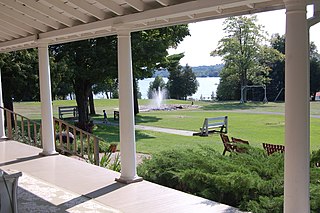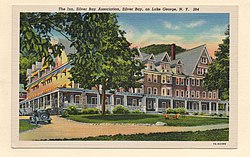
Warren County is a county in the U.S. state of New York. As of the 2020 census, the population was 65,737. The county seat is Queensbury. The county is named in honor of General Joseph Warren, an American Revolutionary War hero of the Battle of Bunker Hill.

Saunderstown is a small village and historic district in the towns of Narragansett and North Kingstown in Washington County, Rhode Island, United States. Saunderstown has its own post office with the ZIP Code of 02874, which also includes a small part of South Kingstown. Its population is 6,245.

Asilomar Conference Grounds is a conference center built for the Young Women's Christian Association (YWCA). It is located east of what was known as Moss Beach on the western tip of the Monterey Peninsula in Pacific Grove, California. Between 1913 and 1929 architect Julia Morgan designed and built 16 of the buildings on the property, of which 11 are still standing. In 1956 it became part of the State Division of Beaches and Parks of California's Department of Natural Resources, and Moss Beach was renamed Asilomar State Beach. Asilomar is a derivation of the Spanish phrase asilo al mar, meaning asylum or refuge by the sea. It is the native homeland of the Rumsen Ohlone people.

Twelfth Street YMCA Building, also known as Anthony Bowen YMCA, was home to the first African American chapter of YMCA, founded in 1853 by Anthony Bowen. It is located at 1816 12th Street NW in the U Street Corridor (Cardozo/Shaw) neighborhood of Washington, D.C. The building was reopened on February 20, 2000 as the Thurgood Marshall Center in honor of the first African American Associate Justice to serve on the United States Supreme Court. The Thurgood Marshall Center now serves as a community center for residents of the U Street Corridor and Shaw neighborhoods. The permanent organization of Phi Beta Sigma fraternity was established in the Bowen Room.

YMCA Boston was founded in 1851 in Boston, Massachusetts, as the first American chapter of YMCA.

The Jonathan Green House is a historic first period Colonial American house, built c. 1700–1720. It is located at 63 Perkins Street, Stoneham, Massachusetts. It was listed on the National Register of Historic Places in 1984. It is one of the oldest structures in Stoneham, and one of only two structures in Stoneham preserving a nearly intact early eighteenth century form.

The United States Post Office–Wakefield Main is a historic post office building at 321 Main Street in Wakefield, Massachusetts. Built in 1936 as part of a Depression-era works project, it is a Classical Revival structure that harmonizes with its neighbors. The building was listed on the National Register of Historic Places in 1987, and included in the Common District in 1990.

Silver Bay is a hamlet in the town of Hague in Warren County, New York, United States. It lies on a small bay on Lake George and is the site of a YMCA conference center. The conference center is one of only a few of its type in the United States and is host to many large groups throughout the year. The center was started in 1900 and has grown ever since. Notable structures include the historic Hepbron Hall, built in 1901, a sprawling Victorian Mansion built in 1895 called Paine Hall, a 700 person auditorium built in 1909, Helen Hughes Chapel, built in 1921, Fisher Gymnasium (1917) and the Boathouse. Many of the buildings are excellent examples of Arts & Crafts Style Architecture. There is also a traditional-style Ice Cream Parlor open during the summer. The Silver Bay YMCA Conference & Family Retreat Center was listed on the National Register of Historic Places in 1980.

The Church of Our Saviour, also known as the Church of Our Saviour at Mission Farm, the Mission of the Church of Our Saviour and the Josiah Wood, Jr., Farm, is an historic Episcopal church and farm complex located at 316 Mission Farm Road, in Killington, Vermont. The church is a Gothic Revival stone building, built in 1894-95 of Vermont granite. In addition to the church, the 170-acre (69 ha) Mission Farm property includes a c. 1817 farmhouse, a guest and retreat house, a vicarage, a bakery and agricultural buildings. On October 29, 1992, it was added to the National Register of Historic Places. The Church of Our Saviour is part of the Three Rivers Regional Ministry of the Episcopal Diocese of Vermont, and the Rev. Lee Allison Crawford is the vicar.

Keauhou Bay is a historic area in the Kona District of the Big Island of Hawaiʻi. The name comes from ke au hou which means "the new era" in the Hawaiian Language.

Greenwich YMCA is a historic building at 50 East Putnam Avenue in Greenwich, Connecticut. Built in 1916 as a gift from Mrs. Nathaniel Witherill, it is a distinctive example of Colonial Revival / Georgian Revival style with Beaux Arts flourishes. The building was listed on the U.S. National Register of Historic Places in 1996.

Wilmington YMCA, also known as Wilmington Central YMCA or just Central YMCA, is a historic YMCA building located in Wilmington, New Castle County, Delaware. It was built in 1929, and is a six-story, red brick and Indiana limestone building in a Spanish Colonial Revival style. It consists of a center six-story, nine-bay main block flanked by five-story, one-bay wings, setback slightly from the main facade.

Craig Healing Springs, also known as the Craig Springs Conference Grounds, is a historic resort property located at Craig Springs, Craig County, west of New Castle, Virginia. It encompasses 23 contributing buildings and 1 contributing structure associated with the Craig Healing Springs resort. They include mostly frame resort cottages in addition to the two-story, brick Oak Lodge. It contains guest rooms and the facilities for the healing baths. The core of the complex is the building known as "Central," which.contained guest registration, rooms, and the kitchen and dining facilities. The property also includes a former dance pavilion, used as an assembly hall. A gazebo marks the location of the springs and stands northwest of the dance pavilion. The resort was incorporated in 1909, and the health spa-resort complex flourished with the advent of automobile travel in the years between the two world wars. It declined in popularity in the 1950s, and was purchased in 1960, as a retreat and conference center for the Christian Church in Virginia.

The Silver Lake Farm is a historic farmstead on Seaver Road in northwestern Harrisville, New Hampshire. Established about 1820, it was a highly successful local farm, serving first businesses as far off as Keene, and then the local summer resort trade at nearby Silver Lake. The house is relatively little-altered despite intensive use into the 20th century. The farmstead was listed on the National Register of Historic Places in 1988.

Pine Crest Inn is a historic resort inn complex located in Tryon, Polk County, North Carolina. The inn and three of the ten cottages were built in 1906 as the Thermal Belt Sanatorium for tuberculosis care. The 2 1/2-story inn and 1 1/2-story cottages are Classical Revival style frame buildings that feature pedimented gables and attached one-story shed porches supported by Tuscan order columns. The remaining cottages were built after the conversion of the property to an inn in 1917. Four of the cottages were built by Pine Crest Inn developer Carter Brown, and two are historic log cabins moved to the property from the eastern Tennessee mountains.
The Battles Wharf Historic District comprises a portion of Battles Wharf, Alabama between Mobile Bay and U.S. Route 98. The area, also called Battles, is a narrow stretch of bayfront with long, deep lots accessible by shell-paved lanes. Houses in the area date from about 1842 to the present day, and are in a distinctive wood-frame cottage style with tall windows and broad porches. Many houses feature so-called "rain porches," deep shed-roofed screened porches attached to the main house and elevated on short masonry piers. The district includes 14 contributing structures and two non-contributing structures. The properties are linked by a public footpath that serves as a thoroughfare. The district has principally functioned as a summer retreat for residents of Mobile, Alabama.

Evergreen Conference District is a music conference center in Jefferson County, Colorado, near Evergreen. It was listed as a historic district on the National Register of Historic Places on May 1, 1979. The district is located at Highway 74 along Bear Creek.

Knoll Farm, also formerly known as McLaughlin Farm, is a historic farm property at 700 Bragg Hill Road in Fayston, Vermont. The farm has seen agricultural use since 1804, and the patterns of use are evident in the surviving farm buildings and landscape. The property, is still actively farmed and also used as a retreat center and is listed on the National Register of Historic Places in 1996.

Huguenot is a hamlet in the town of Deerpark, in Orange County, New York, United States. It is located north of Port Jervis on US-209. Huguenot Schoolhouse and Neversink Valley Grange Hall No. 1530 are listed on the National Register of Historic Places. The community was named after Huguenot immigrants. Huguenot is also named for Huguenot families Cuddeback and Gumaer who settled the area in 1698. The Indian name for the area was Seneyaugnquan.

Fountain Point Resort is a historic landmark located on the eastern shore of South Lake Leelanau in Suttons Bay Township, Michigan. Its name is derived from a fountain of sparkling artesian spring water, situated on a large point on Lake Leelanau, which has been continuously gushing since 1867.























